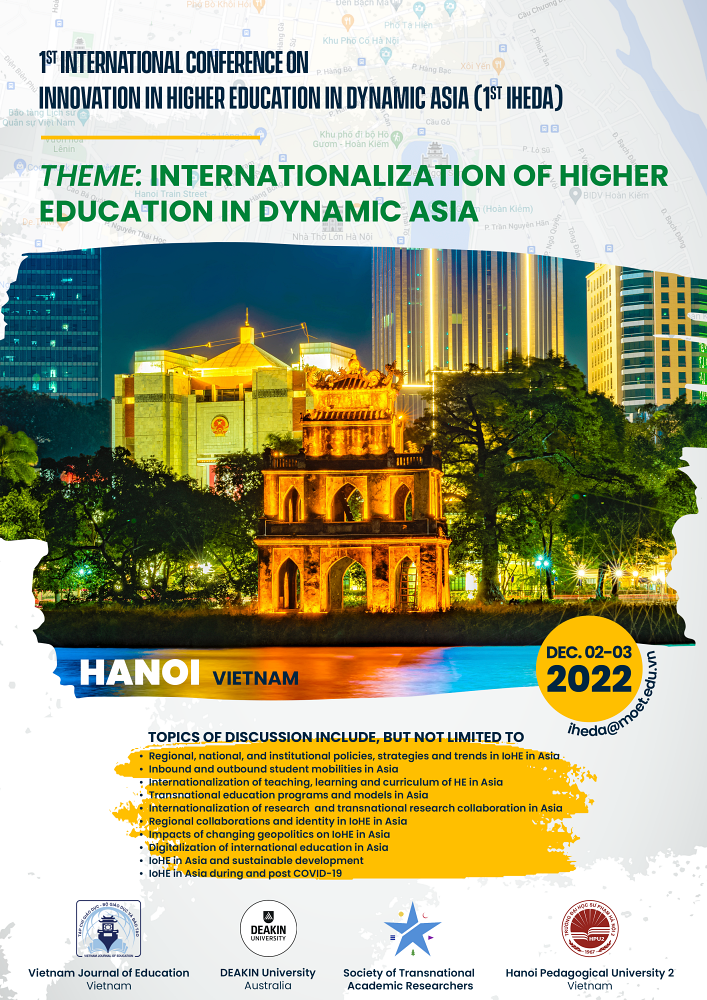Mobile technology to promote education 4.0 in Vietnam
DOI:
https://doi.org/10.52296/vje.2020.73-
Downloads
How to Cite
Abstract
Currently, with development of technology, the use of gadgets like smart devices (smartphones, tablets) is becoming more common. In recent years, mobile technologies play an increasingly important role in students’ lives, study and scientific research. In addition, currently most students in higher education institutions use smartphones. Many universities use electronic devices such as smart phones, laptops, computers, and tablets as teaching devices and building websites that run on mobile platforms or developing applications that can be easily downloaded from google play or Apple store. Therefore, this article focuses on analyzing the perspectives as well as the application of learning on mobile devices in higher education 4.0. Surveys of students owning a mobile device and doing their learning on a mobile phone show that the currently students owning mobile devices is high and will continue to increase. The data was analyzed through the calculation of the proportion of responses in the questionnaires. The article also summarizes the results of short discussions about the results of the research, finding that mobile technologies play an important role in teaching and learning in the current context of higher education in Vietnam. Based on the results, the authors recommend that more studies should be done to provide knowledge regarding the application and development of mobile technologies in learning and research of students towards the era of industrial revolution 4.0 (IR4).
Downloads
References
Caves, N. & Al-Momani, M. M. (2011). Mobile system for flexible education. Procedia Computer Science, 3, 1475-1479. https://doi.org/10.1016/j.procs.2011.01.034
Chen, B. & Danyelle’s, A. (2013). Exploring students’ mobile learning practices in higher education. Retrieved from https://er.educause.edu/articles/2013/10/exploring-students-mobile-learning-practices-in-higher-education
Crescente, M. L., & Lee, D. (2011). Critical issues of M-Learning: design models, adoption processes, and future trends. Journal of the Chinese Institute of Industrial Engineers, 28(2), 111-123. https://doi.org/10.1080/10170669.2010.548856
European Commission. (2017). Education 4.0 Mobile Learning. Luxembourg: Office for Official Publications of the European Communities.
Graham, E. (2020). Using smartphones in the classroom. Retrieved from http://www.nea.org/tools/56274.htm
Kukulska-Hulme, A. (2009). Will mobile learning change language learning? Recall, 21(2), 157-165. http://dx.doi.org/10.1017/S0958344009000202
Kukulska-Hulme, A. (2013). Re-skilling language learners for a mobile world. The International Research Foundation for English Language Education (TIRF), Monterey, USA. https://www.tirfonline.org/publications/mobile-assisted-language-learning/re-skilling-language-learners-for-a-mobile-world
Kukulska-Hulme, A., & Shield, L. (2008). An overview of mobile assisted language learning: From content delivery to supported collaboration and interaction. Recall, 20(3), 271-289. https://doi.org/10.1017/S0958344008000335
LaRue, J. & Järvelä, S. (2008). Using web 2.0 software and mobile devices for creating shared understanding among virtual learning communities. Fifth IEEE International Conference on Wireless, Mobile, and Ubiquitous Technology in Education.
Pinkwart, N., Jansen, M., Olinger, M., Korchounova, L., & Hoppe, U. (2004). Partial generation of contextualized metadata in a collaborative modeling environment. In L. Arroyo and C. Tasso (Eds.), Workshop Proceedings of the 3rd International Conference on Adaptive Hypermedia. Technical University, Eindhoven (NL), 372-376.
Saville, S., & Attewell, J. (2004). Mobile learning and social inclusion: focusing on learners and learning. In Learning with Mobile Devices: Research and Development. LSDA .UK.
Traxler, J. (2007). Defining, Discussing and Evaluating Mobile Learning: The moving finger writes and having writ.... The International Review of Research in Open and Distributed Learning, 8(2). https://doi.org/10.19173/irrodl.v8i2.346




















